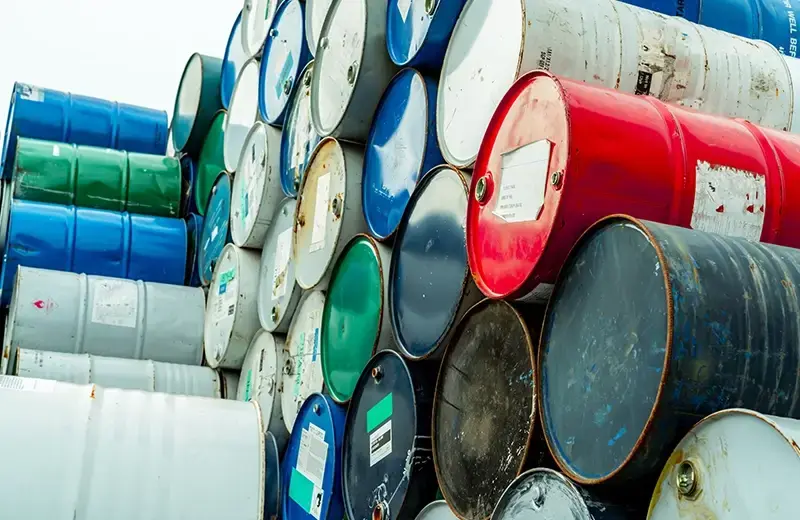The process of reconditioning 55-gallon steel drums has long been a key component in helping waste haulers save time and money. But the environmental impact of the reconditioning process has recently prompted waste haulers to rethink this practice, especially after the Environmental Protection Agency (EPA) issued the Used Drum Management and Reconditioning Advanced Notice of Proposed Rulemaking last September.
While the tide was already turning on the costs and lead time associated with reconditioning 55-gallon steel drums for multiple waste hauling applications, the surfacing of the environmental impact is prompting waste haulers to look for steel drum alternatives in advance of potential shifts in regulatory compliance on the reconditioning process.
Here, we’ll look at a couple of reasons why waste haulers are moving away from using reconditioned 55-gallon steel drums, and how Gorilla Drum™ can help waste haulers make a seamless transition to a more sustainable, efficient waste hauling solution.
 Reconditioning 55-gallon steel drums for continued waste hauling is a time-intensive process
Reconditioning 55-gallon steel drums for continued waste hauling is a time-intensive process
Waste hauling is a volume industry where operators need to maximize uptime and productivity. While reconditioning 55-gallon steel drums does in some ways help avoid the supply chain bottlenecks with sourcing new steel drums, the reconditioning process comes with its own challenges, particularly in the time-intensive nature of the reconditioning process.
Waste haulers must transport used steel drums to a reconditioning facility. Drums are then essentially cleansed of any remaining hazardous materials either by burning off residual chemicals or toxins, or by intense washdown processes that use harsh, caustic solutions in order to ensure the drum is properly cleaned for subsequent use.
After the reconditioning process, drums are inspected to ensure they comply with the Resource Conservation and Recovery Act (RCRA) empty container provision, which certifies a reconditioned drum for additional use.
The reconditioning of steel drums often results in prolonged lead times for a couple of reasons.
First, the inefficient nature of transporting steel drums to reconditioning facilities often means utilizing multiple full-truckloads (FTLs) in order to accommodate demand. For example, a standard 53-foot flatbed can fit just 208 steel drums, and, for large scale waste haulers, the process of simply transporting drums to a reconditioning facility can be costly and time consuming.
Plus, steel drum reconditioning facilities operate at such large volumes that waste haulers are often subjected to extended lead times in the delivery of reconditioned drums. What’s more, the thorough nature of the reconditioning process can cause further delays.
Time is money for waste haulers, and if you’re not hauling, you’re not earning. Gorilla Drum™ virtually eliminates the need for reconditioning by using a flexible plastic liner that fits neatly inside each unit. This liner can be recycled after every use, and Gorilla Drum’s™ collapsible frame helps you fit more units on a standard flatbed truck — 20x more.
Using reconditioned steel drums poses significant damage to the environment
Aside from the increased number of trucks on the road necessary to transport used steel drums to a reconditioning facility, the reconditioning process itself poses some significant risks to the environment, not to mention the potential for workplace accidents.
The EPA’s recent Drum Reconditioner Damage Case Report found some startling statistics about the number of incidents at drum reconditioning facilities that resulted in the exposure of hazardous or environmentally damaging materials.
For example, of the 181 drum reconditioning facilities identified in the report, 86 facilities reported incidents that resulted in damage to the environment, infrastructure, or personnel. This figure represents more than 47% of all reconditioning sites, and these incidents included fire; groundwater contamination; air and soil contamination; employee injury; and even loss of life.
Such incidents are usually caused by residual hazardous waste that still remains in the drum even after the reconditioning process. In addition, the EPA case report found that a percentage of reconditioning facilities were not adhering to the RCRA empty container provision.
This means that waste haulers can potentially be using reconditioned drums that still contain trace amounts of hazardous waste, and it also leaves the door open for a number of dangers due to contamination, including fires and/or explosions.
These types of incidents aside, the reconditioning process itself is fraught with environmental dangers. Burning off hazardous materials inside the drum can cause a significant amount of air pollution, even if proper RCRA protocols are followed. And the washdown process requires the use of chemical solvents that can pose significant risk to both the environment and those reconditioning the steel drum.
The reconditioning of 55-gallon steel drums comes with quite a bit of baggage, both in terms of time and money, and in the possibility of damage to the environment. Gorilla Drum™ is a 100% recyclable, eco-friendly solution that does not require any reconditioning for repeat use. Plus, Gorilla Drum™ is rated for use with the three major packing groups of hazardous material:
- Packing Group I, which consists of materials presenting a high degree of danger
- Packing Group II, which contains materials presenting a medium degree of danger
- Packing Group III, which consists of materials presenting a low degree of danger
With Gorilla Drum™, waste haulers can experience a more efficient, sustainable solution that saves time and money. Learn more about how Gorilla Drum can help you get the steel drum monkey off your back, or tell us about your waste hauling needs and we’ll connect with you soon.


 Reconditioning 55-gallon steel drums for continued waste hauling is a time-intensive process
Reconditioning 55-gallon steel drums for continued waste hauling is a time-intensive process